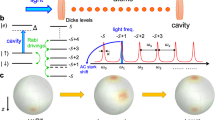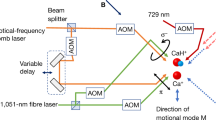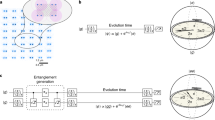Abstract
Entanglement is recognized as a key resource for quantum computation1 and quantum cryptography2. For quantum metrology, the use of entangled states has been discussed3,4,5 and demonstrated6 as a means of improving the signal-to-noise ratio. In addition, entangled states have been used in experiments for efficient quantum state detection7 and for the measurement of scattering lengths8. In quantum information processing, manipulation of individual quantum bits allows for the tailored design of specific states that are insensitive to the detrimental influences of an environment9. Such ‘decoherence-free subspaces’ (ref. 10) protect quantum information and yield significantly enhanced coherence times11. Here we use a decoherence-free subspace with specifically designed entangled states12 to demonstrate precision spectroscopy of a pair of trapped Ca+ ions; we obtain the electric quadrupole moment, which is of use for frequency standard applications. We find that entangled states are not only useful for enhancing the signal-to-noise ratio in frequency measurements—a suitably designed pair of atoms also allows clock measurements in the presence of strong technical noise. Our technique makes explicit use of non-locality as an entanglement property and provides an approach for ‘designed’ quantum metrology.
This is a preview of subscription content, access via your institution
Access options
Subscribe to this journal
Receive 51 print issues and online access
$199.00 per year
only $3.90 per issue
Buy this article
- Purchase on Springer Link
- Instant access to full article PDF
Prices may be subject to local taxes which are calculated during checkout




Similar content being viewed by others
References
Nielsen, M. A. & Chuang, I. L. Quantum Computation and Quantum Information (Cambridge Univ. Press, Cambridge, UK, 2000)
Gisin, N., Ribordy, G., Tittel, W. & Zbinden, H. Quantum cryptography. Rev. Mod. Phys. 74, 145–195 (2002)
Giovannetti, V., Loyd, S. & Maccone, L. Quantum-enhanced measurements: beating the standard quantum limit. Science 306, 1330–1336 (2004)
Giovannetti, V., Loyd, S. & Maccone, L. Quantum metrology. Phys. Rev. Lett. 96, 010401 (2006)
Bollinger, J. J., Itano, W. M., Wineland, D. J. & Heinzen, D. J. Optimal frequency measurements with maximally correlated states. Phys. Rev. A 54, R4649–R4652 (1996)
Leibfried, D. et al. Toward Heisenberg-limited spectroscopy with multiparticle entangled states. Science 304, 1476–1478 (2004)
Schmidt, P. O. et al. Spectroscopy using quantum logic. Science 309, 749–752 (2005)
Widera, A. et al. Entanglement interferometry for precision measurement of atomic scattering properties. Phys. Rev. Lett. 92, 160406 (2004)
Kielpinski, D. et al. A decoherence-free quantum memory using trapped ions. Science 291, 1013–1015 (2001)
Lidar, D. A., Chuang, I. L. & Whaley, K. B. Decoherence-free subspaces for quantum computation. Phys. Rev. Lett. 81, 2594–2597 (1998)
Roos, C. F. et al. Bell states with ultra-long lifetimes and their tomographic state analysis. Phys. Rev. Lett. 92, 220402 (2004)
Roos, C. F. Precision frequency measurements with entangled states. Preprint at http://arxiv.org/quant-ph/0508148 (2005).
Ramsey, N. F. A molecular beam resonance method with separated oscillating fields. Phys. Rev. 78, 695–699 (1950)
Häffner, H. et al. Robust entanglement. Appl. Phys. B 81, 151–153 (2005)
Langer, C. et al. Long-lived qubit memory using atomic ions. Phys. Rev. Lett. 95, 060502 (2005)
Madej, A. A. & Bernard, J. E. Frequency Measurement and Control (ed. Luiten, A. N.) 153–195 (Topics in Applied Physics Vol. 79, Springer, Berlin/Heidelberg, 2001)
Diddams, S. A., Bergquist, J. C., Jefferts, S. R. & Oates, C. W. Standards of time and frequency at the outset of the 21st century. Science 306, 1318–1324 (2004)
Itano, W. M. External-field shifts of the 199Hg+ optical frequency standard. J. Res. Natl Inst. Stand. Technol. 105, 829–837 (2000)
Oskay, W. H., Itano, W. M. & Bergquist, J. C. Measurements of the 199Hg+ 5d96s22D5/2 electric quadrupole moment and a constraint on the quadrupole shift. Phys. Rev. Lett. 94, 163001 (2005)
Barwood, G. P., Margolis, H. S., Huang, G., Gill, P. & Klein, H. A. Measurement of the electric quadrupole moment of the 4d 2D5/2 level in 88Sr+. Phys. Rev. Lett. 93, 133001 (2004)
Schneider, T., Peik, E. & Tamm, Chr. Sub-Hertz optical frequency comparisons between two trapped 171Yb+ ions. Phys. Rev. Lett. 94, 230801 (2005)
Itano, W. M. Quadrupole moments and hyperfine constants of metastable states of Ca+, Sr+, Ba+, Yb+, Hg+, and Au. Phys. Rev. A 73, 022510 (2006)
Sur, C. et al. Electric quadrupole moments of the D states of alkaline-earth-metal ions. Phys. Rev. Lett. 96, 193001 (2006)
Schmidt-Kaler, F. et al. How to realize a universal quantum gate with trapped ions. Appl. Phys. B 77, 789–796 (2003)
Roos, Ch. et al. Quantum state engineering on an optical transition and decoherence in a Paul trap. Phys. Rev. Lett. 83, 4713–4716 (1999)
Margolis, H. S. et al. Hertz-level measurement of the optical clock frequency in a single 88Sr+ ion. Science 306, 1355–1358 (2004)
Dubé, P. et al. Electric quadrupole shift cancellation in single-ion optical frequency standards. Phys. Rev. Lett. 95, 033001 (2005)
Acknowledgements
We thank H. Häffner for his contributions to the optical pumping scheme and acknowledge help with the experiment from T. Körber, W. Hänsel, D. Chek-al-kar, M. Mukherjee and P. Schmidt. We acknowledge support by the Austrian Science Fund (FWF), by the European Commission (SCALA, CONQUEST networks), and by the Institut für Quanteninformation GmbH. This material is based on work supported in part by the US Army Research Office.
Author information
Authors and Affiliations
Corresponding author
Ethics declarations
Competing interests
Reprints and permissions information is available at www.nature.com/reprints. The authors declare no competing financial interests.
Rights and permissions
About this article
Cite this article
Roos, C., Chwalla, M., Kim, K. et al. ‘Designer atoms’ for quantum metrology. Nature 443, 316–319 (2006). https://doi.org/10.1038/nature05101
Received:
Accepted:
Issue Date:
DOI: https://doi.org/10.1038/nature05101
This article is cited by
-
Requirements for a processing-node quantum repeater on a real-world fiber grid
npj Quantum Information (2023)
-
Compensation of power line-induced magnetic interference in trapped-ion system
Applied Physics B (2023)
-
Improvement in phase-sensitivity of a Mach–Zehnder interferometer with the superposition of Schrödinger’s cat-like state with vacuum state as an input under parity measurement
Optical and Quantum Electronics (2023)
-
An elementary quantum network of entangled optical atomic clocks
Nature (2022)
-
Discrimination and estimation for dephasing sources of trapped ion qubits
Applied Physics B (2020)
Comments
By submitting a comment you agree to abide by our Terms and Community Guidelines. If you find something abusive or that does not comply with our terms or guidelines please flag it as inappropriate.



